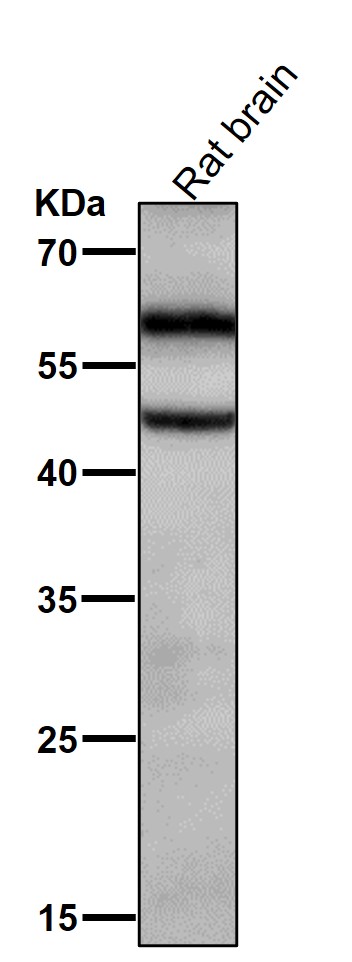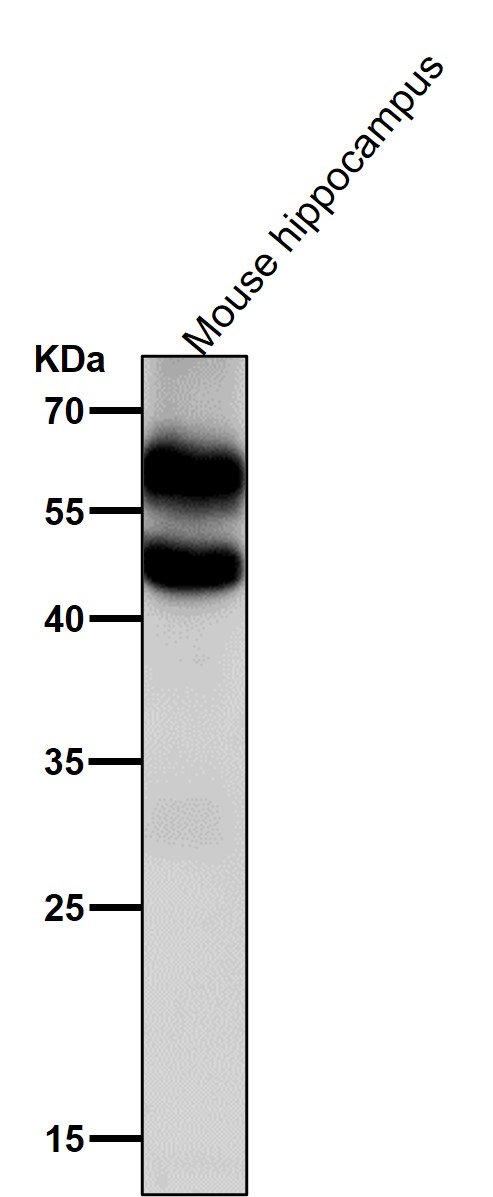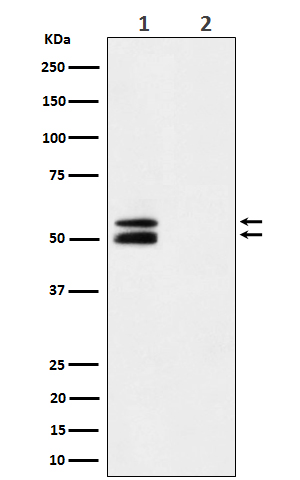


| WB | 咨询技术 | Mouse,Rat |
| IF | 咨询技术 | Mouse,Rat |
| IHC | 1/100-1/200 | Mouse,Rat |
| ICC | 技术咨询 | Mouse,Rat |
| FCM | 咨询技术 | Mouse,Rat |
| Elisa | 咨询技术 | Mouse,Rat |
| Aliases | Camk2; Camk2a; Camk2b; CAMKA; CaMKII; CaMKIINalpha;;p-CaMKII alpha (T286) |
| WB Predicted band size | Calculated MW: 54 kDa ; Observed MW: 50-60 kDa |
| Host/Isotype | Rabbit IgG |
| Antibody Type | Primary antibody |
| Storage | Store at 4°C short term. Aliquot and store at -20°C long term. Avoid freeze/thaw cycles. |
| Species Reactivity | Mouse,Rat |
| Immunogen | A synthesized peptide derived from mouse CaMKII alpha around the phosphorylation site of T286 |
| Formulation | Purified antibody in PBS with 0.05% sodium azide,0.05% BSA and 50% glycerol. |
+ +
以下是关于Phospho-CaMKIIα(T286)抗体的3篇参考文献,按研究领域和内容概括整理:
---
1. **文献名称**: "Dual role of calmodulin in autophosphorylation of multifunctional CaM kinase"
**作者**: Hanson PI, Meyer T, Stryer L, Schulman H
**摘要**: 该研究阐明了CaMKIIα在Thr286位点的自磷酸化机制,揭示了钙/钙调素依赖性激活与自主活化的双重调控。实验中通过磷酸化特异性抗体验证了T286磷酸化对酶活性持续激活的关键作用。
2. **文献名称**: "Autophosphorylation-dependent targeting of calcium/calmodulin-dependent protein kinase II by the AP-1 adaptor complex"
**作者**: Bayer KU, Löhler J, Schulman H, Harbers K
**摘要**: 研究利用Phospho-T286抗体证明,CaMKIIα的Thr286磷酸化促进其与突触后支架蛋白的结合,并参与神经元突触可塑性的调控,为长时程增强(LTP)的分子机制提供了证据。
3. **文献名称**: "CaMKIIα phosphorylation of spinophilin modulates spine structural plasticity"
**作者**: Terry-Lorenzo RT, Roadcap DW, Otsuka T, Blanpied TA, et al.
**摘要**: 通过免疫印迹和免疫荧光技术,该研究发现T286磷酸化的CaMKIIα通过磷酸化突触蛋白spinophilin调控树突棘形态变化,揭示了其在突触重塑中的功能。
---
**备注**:上述文献均以Phospho-CaMKIIα(T286)抗体为工具,聚焦于该磷酸化位点在酶活性、突触可塑性及疾病模型中的作用。如需具体年份或期刊信息,可进一步补充数据库检索结果。
The Phospho-CaMKIIα (Thr286) antibody detects the activated form of calcium/calmodulin-dependent protein kinase II alpha (CaMKIIα), a key regulator of synaptic plasticity and memory formation. CaMKIIα is a serine/threonine kinase highly enriched in the brain, particularly in postsynaptic densities. Its activation requires calcium/calmodulin binding, which induces autophosphorylation at Thr286—a critical step that sustains kinase activity even after calcium levels decline, enabling long-term potentiation (LTP). This antibody specifically recognizes CaMKIIα phosphorylated at Thr286. making it a vital tool for studying neuronal signaling dynamics, learning/memory mechanisms, and pathologies like Alzheimer’s disease or epilepsy.
Researchers use this antibody in techniques like Western blotting, immunohistochemistry, or immunofluorescence to map spatial-temporal activation patterns in brain tissues or cultured neurons under stimuli (e.g., glutamate, KCl depolarization). It helps differentiate basal vs. activity-dependent phosphorylation states, aiding investigations into synaptic strengthening, dendritic spine remodeling, or drug effects on kinase pathways. Specificity is often confirmed via knockout controls or peptide blocking assays. Notably, Thr286 autophosphorylation also promotes CaMKIIα translocation to synapses, influencing downstream targets (e.g., glutamate receptors). Dysregulation of this pathway is linked to neuropsychiatric disorders, underscoring the antibody’s relevance in both basic and translational neuroscience.
×